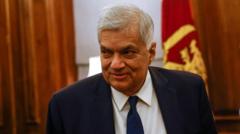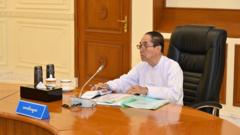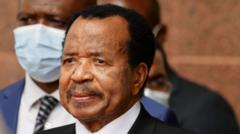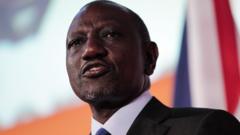SALT LAKE CITY (AP) — A former Utah Supreme Court justice is expected to be named the next president of The Church of Jesus Christ of Latter-day Saints after the death of President Russell M. Nelson over the weekend.
Announcing his successor — Dallin H. Oaks — is largely a formality because the church has a well-defined leadership hierarchy that has governed it for decades. Nothing will change in the leadership body until some time after Nelson’s funeral, which is scheduled for Oct. 7.
### Who leads the church?
The Church of Jesus Christ of Latter-day Saints, known widely as the Mormon church, is led by a president and his two top counselors, forming what is known as the First Presidency. They usually come from a governing body called the Quorum of the Twelve Apostles, which sits just below the First Presidency and helps set church policy while overseeing the faith’s business interests. Together, these 15 top officials are all men in accordance with the church’s all-male priesthood.
### How are the presidents chosen?
The longest-tenured member of the Quorum of the Twelve becomes the new president in a tradition established more than a century ago to ensure a smooth handover and prevent any lobbying internally or publicly. The succession plan was created in 1889 following nearly two years of debate and some politicking among the apostles after the faith’s third president, John Taylor, died. Since then, the plan has been carried out without exception.
Nelson, the faith’s oldest-ever president, died Saturday at the age of 101. Per protocol, his successor won’t be formally announced until some time after his funeral next week. With his death, the First Presidency automatically dissolved and his two counselors rejoined the Quorum, bringing its number to 14.
Until a new president is announced, the Quorum, now led by Oaks, is in charge as the Utah-based faith prepares for its twice-annual general conference in Salt Lake City this weekend.
### What does the president do?
He is considered a prophet, seer and revelator who leads the church through divine revelation from God along with two top counselors and members of the Quorum of the Twelve. He sets policy, interprets doctrine and manages church programs.
The president also oversees the church’s businesses, which include real estate, farms, publishing, life insurance, nonprofits, universities, a Polynesian cultural center in Hawaii and an upscale open-air shopping mall in Salt Lake City. The church doesn’t disclose or discuss its finances, but the latest filings from its investment arm, Ensign Peak Advisors, Inc., value its portfolio at $58 billion.
### How long do the presidents serve?
Presidents serve until they die, which is why the length of their tenures vary widely. The longest was Brigham Young, who served nearly 30 years in the mid- to late 1800s. Other lengthy tenures include Heber J. Grant, with nearly 27 years from 1918 to 1945, and David O. McKay, with nearly 19 years from 1951 to 1970.
The shortest tenure was Howard H. Hunter, who served only nine months from 1994 to 1995. He and three other church presidents served less than five years. Nelson held the position for more than seven years.
### How are the president’s two counselors chosen?
A new president usually chooses counselors from the Quorum of the Twelve. Sometimes, they are the same men who served the previous president. If they’re different, the previous counselors return to being members of the Quorum.
Oaks happens to be next in line, having joined the Quorum in May 1984.
### How are new Quorum members chosen?
They can come from anywhere. In modern history, most were already serving in lower-tier leadership councils. The apostles tend to be older men who have achieved success in occupations outside the church.
Once Oaks becomes president and selects his two counselors, the Quorum will likely be left with one vacancy for him to fill — one way church presidents can leave their imprint.
### What about women?
Women hold leading positions in councils that run programs for women and girls, with the president and two counselors who oversee the Relief Society considered the top female leaders based on the organization’s historical cachet.
Announcing his successor — Dallin H. Oaks — is largely a formality because the church has a well-defined leadership hierarchy that has governed it for decades. Nothing will change in the leadership body until some time after Nelson’s funeral, which is scheduled for Oct. 7.
### Who leads the church?
The Church of Jesus Christ of Latter-day Saints, known widely as the Mormon church, is led by a president and his two top counselors, forming what is known as the First Presidency. They usually come from a governing body called the Quorum of the Twelve Apostles, which sits just below the First Presidency and helps set church policy while overseeing the faith’s business interests. Together, these 15 top officials are all men in accordance with the church’s all-male priesthood.
### How are the presidents chosen?
The longest-tenured member of the Quorum of the Twelve becomes the new president in a tradition established more than a century ago to ensure a smooth handover and prevent any lobbying internally or publicly. The succession plan was created in 1889 following nearly two years of debate and some politicking among the apostles after the faith’s third president, John Taylor, died. Since then, the plan has been carried out without exception.
Nelson, the faith’s oldest-ever president, died Saturday at the age of 101. Per protocol, his successor won’t be formally announced until some time after his funeral next week. With his death, the First Presidency automatically dissolved and his two counselors rejoined the Quorum, bringing its number to 14.
Until a new president is announced, the Quorum, now led by Oaks, is in charge as the Utah-based faith prepares for its twice-annual general conference in Salt Lake City this weekend.
### What does the president do?
He is considered a prophet, seer and revelator who leads the church through divine revelation from God along with two top counselors and members of the Quorum of the Twelve. He sets policy, interprets doctrine and manages church programs.
The president also oversees the church’s businesses, which include real estate, farms, publishing, life insurance, nonprofits, universities, a Polynesian cultural center in Hawaii and an upscale open-air shopping mall in Salt Lake City. The church doesn’t disclose or discuss its finances, but the latest filings from its investment arm, Ensign Peak Advisors, Inc., value its portfolio at $58 billion.
### How long do the presidents serve?
Presidents serve until they die, which is why the length of their tenures vary widely. The longest was Brigham Young, who served nearly 30 years in the mid- to late 1800s. Other lengthy tenures include Heber J. Grant, with nearly 27 years from 1918 to 1945, and David O. McKay, with nearly 19 years from 1951 to 1970.
The shortest tenure was Howard H. Hunter, who served only nine months from 1994 to 1995. He and three other church presidents served less than five years. Nelson held the position for more than seven years.
### How are the president’s two counselors chosen?
A new president usually chooses counselors from the Quorum of the Twelve. Sometimes, they are the same men who served the previous president. If they’re different, the previous counselors return to being members of the Quorum.
Oaks happens to be next in line, having joined the Quorum in May 1984.
### How are new Quorum members chosen?
They can come from anywhere. In modern history, most were already serving in lower-tier leadership councils. The apostles tend to be older men who have achieved success in occupations outside the church.
Once Oaks becomes president and selects his two counselors, the Quorum will likely be left with one vacancy for him to fill — one way church presidents can leave their imprint.
### What about women?
Women hold leading positions in councils that run programs for women and girls, with the president and two counselors who oversee the Relief Society considered the top female leaders based on the organization’s historical cachet.






















